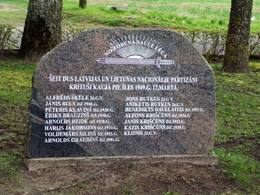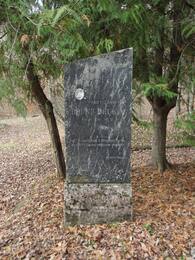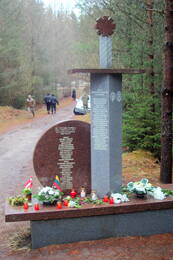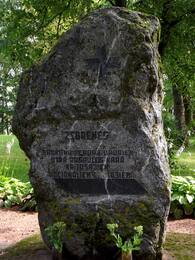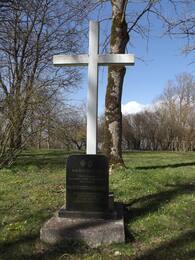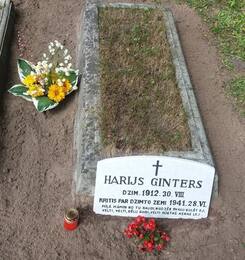Resistance to the Soviet occupation regime in Zemgale
Day 1.
109 km
Bērze parish – Naudīte parish - Zebrene parish - Ukru parish – Zaļenieki parish
Practical info
* Driving distance: ~109 km. Most of the roads are paved, but access to more remote areas may be via gravel roads.
* There are very few places to eat lunch and dinner along the route. You can order a meal in advance or bring your own food for lunch.
* Memorials can be viewed at any time
* The itinerary is intended as a guide - how to optimally travel around a region or country with the aim of getting to know its military heritage;
* The traveler plans how many of the recommended objects and places he can explore in one day;
* Before traveling, you should check the opening hours of sightseeing places (museums, collections, fortifications, etc.);
* For places where advance booking is required (local guides, private collections, etc.), a visit must be booked, specifying the date and time. If the trip is cancelled, the places booked must be informed;
* Accommodation must be booked in advance. Accommodation may be unavailable during the summer season, especially on the coast. Some catering establishments may not be open during the winter season;
* Choose not only summer for your trip, but also other seasons;
* Visit tourist information centers where you can get additional information, brochures, and maps.
Sights
The Brothers' Cemetery of the Īle National Partisans in the Virkus Cemetery, Bērze Parish
The Īle National Partisan Brothers' Cemetery in the Virkus cemetery of Bērze parish was established on November 14, 1992, when 15 partisans who fell in the Battle of Īle on March 17, 1949, were buried here. This was possible after on July 18, 1992, the National Guard, together with the organization "Daugavas Vanagi" and the Latvian history research working group "Ziemeļblāzma", with the participation of representatives of other nationally-minded organizations, exhumed the remains of 15 Latvian and Lithuanian forest brothers buried in a blown-up partisan bunker in the Īle forest district of Zebrene parish.
The memorial stone to the national partisans who fell in the Battle of Īle was unveiled on May 29, 1993. It was designed by Alfons Kalniņš ("Edgars"), one of the surviving participants in the battle of March 17, 1949. The regular-shaped granite slab depicts a sword and a rising sun, and is engraved with the names of 15 fallen national partisans and the inscription:
“The sun rose from the sword. Here lie the Latvian and Lithuanian national partisans who fell in the battle of Īle on March 17, 1949.”
The gravestone of the national partisan Bruno Druķis, who fell in 1941, in the Jaunsesava cemetery, Naudīte parish
Gravestone for Bruno Druķis, a national partisan from Naudīte parish, who fell in a clash with the armed formations of the Soviet occupation authorities on June 30, 1941. A granite stele with the text: “To the partisan Bruno Druķis. Fell on June 30, 1940. This land is a sacred heritage for our people. And blessed is he who falls for him. Naudīte parish”. The ceramic medallion with the portrait of B. Druķis was smashed and destroyed after World War II.
After the start of the German-USSR war, about ten local guards gathered in the Ružēni forest on June 27, 1941 and formed a national partisan unit with Žanis Gelsons at the head. The next day, the partisans occupied the Naudīte parish executive committee and the local machine and horse rental station, taking possession of the tractors, agricultural equipment and horses there. On June 30, the Naudīte partisan unit tried to intercept a column of Red Army soldiers led by two officers on the road near Meļļi. During the clash, both Soviet officers and retired corporal Bruno Druķis of the Latvian Army Cavalry Regiment fell.
Īle National Partisan Bunker
The bunker is located in the Īle forestry of Zebrene Rural Territory, at the turn-off from the P104 Biksti-Auce Road.
The Kārlis Krauja Group of Īle National Partisans was formed in 1947. V. Z. Brizga (alias K. Krauja) was appointed the commander of the group. In October 1948, the Krauja Group merged with a group of Lithuanian national partisans. Krauja Group operated in Jelgava District and consisted of 27 national partisans.
In October 1948, Krauja Group built an underground bunker in Lielauce Parish, Jelgava County, not far from the Īle Forestry, 300 metres to the north of the “Priedaišu” house. Its total length, including battle passages, was 45 metres. 70 remote-controlled mines were planted around the bunker. The bunker was equipped with a furnace, a well, a toilet, and a storage room.
On 17 March 1949, the 24 partisans who were in the bunker at the time fought their last battle against the 760-strong troops of the Ministry of National Security or Cheka. After the battle, 9 members of the group were arrested, while 15 fell in the battle, with eight of them being Latvian and seven being Lithuanian. In 1992, the Home Guards, together with the Daugavas Vanagi (Hawks of the Daugava), unearthed the bunker that had been blown up. A White Cross, a memorial stone and a granite statue were erected at the site.
Inside the bunker, you can see a stove, a table, and narrow benches on which the partisans slept. Information boards and memorial stones with the names of the partisans have been installed at the bunker.
Memorial to the victims of the struggle against the Soviet occupation and communist repression in Zebrene parish
A memorial to those who fought against the Soviet occupation regime and the victims of communist repression in the Renģe Manor Park of Zebrene Parish was opened on September 1, 1995. A cross is depicted on a rough boulder and the words are engraved: “To the victims of the Zebrene red terror, to the national fighters who fell in World War II.” The creation of the memorial was financially supported by the organization “Daugavas Vanagi”.
Memorial to Latvian and Lithuanian national partisans in Ukru parish
The memorial site for Latvian and Lithuanian national partisans near the former Ukru parish school was opened and consecrated on October 21, 2006. A white cross has been erected there, at the foot of which there is a granite stele with the names of two Latvian and two Lithuanian national partisans engraved and the text: “For You, Fatherland. To the national partisans of Ukru parish 1944-1954. In the fight against the communist occupation regime on October 26, 1948, Eidis-Eduards Ozols, Kristaps Siļķe, Alfonsas Bugnius, Kostas Norvaitis fell in Ukru parish”.
The memorial site was established by the Latvian National Partisan Association (LNPA) in cooperation with the Lithuanian Freedom Fighters Association (LLKS). Its opening was attended by the chairman of the Ukru Parish Council Ainārs Āriņš, the chairman of the LNPA Ojārs Stefans, the representative of the LLKS Jons Čepons and other attendees.
The gravestone of the national partisan Harijs Günters, who fell in 1941, in the Ūziņi Prieži cemetery in Zaļenieki parish
Gravestone for the national partisan of Jēkabnieki parish, Harijs Ginter, who fell on June 28, 1941. A plaque is installed on the grave with the text: “Harijs Ginter. Born 1912.30. VIII. Fell for his native land 1941.28.VI. Dear mother, What you cry, extinguish the scale, go to sleep,. In vain, in vain, wait for your son, in vain do you shed bitter tears”. The gravestone was restored in 2016 and 2024 at the initiative of Gunita Kulmane, the head of the Ūziņi library of Zaļenieki parish, and at her personal expense.
In the days following the outbreak of the German-USSR war on June 22, 1941, a national partisan unit was formed in Jēkabnieki parish to ensure order and end the Soviet occupation power, with the commander of the guard platoon V. Ritums at the head. Initially, the weak armament – a few pistols and rifles – was supplemented with trophy weapons from the Red Army soldiers captured near Kalnanši and in other places. A major clash with Soviet armed formations took place on June 28, 1941 in Gudēni, where the guard of Jēkabnieki parish and national partisan H. Ginter was captured and tortured to death.
https://www.visit.jelgava.lv/lv/
Places to eat
The “La Tour de Marie” restaurant
The restaurant is on the eight floor of the steeple of the Church of the Holy Trinity in Jelgava, offering an outstanding view of the town’s most important cultural and historical monuments. The restaurant offers fine dining on the basis of French cuisine, as well as everyday and business meals.
Latvian cuisine: Herring filet with cottage cheese, potatoes and onions.
Special foods: Marija cake.
The “Istaba” saloon
The saloon is in the centre of Jelgava alongside the bridge over the Driksa River, where there is a new shoreline promenade. Wood has been used for interior design, and the saloon regularly organises musical evenings.
Latvian cuisine: Cold soup, roast filet of plaice or cod farmer’s breakfast, potato pancakes, crepes.
Restorāns - picērija "Tomato Pica"
The restaurant – pizzeria Tomato Pica is situated in the centre of the city of Jelgava, in the shopping centre Pilsetas Pasaza. Elegant and comfortable restaurant premises for enjoying your food, soft music in the background and polite, professional servers.
Tomato Pica offers all classical types of pizza, baked using special sauce recipes and dough typical for Italy, as well as different salads, appetizers, desserts and drinks. The restaurant –cafe Tomato Pica is suitable both for family rest and for business lunches.
The “Silva” bistro, bakery and café
The bistro is in the centre of Jelgava and offers fresh canapés, cakes, pierogi, cookies and other baked goods. It works with local producers of ingredients.
Latvian cuisine: Bacon pierogi, potato pancakes, wheat-potato porridge with bacon sauce, whipped fool with milk. Grey peas with bacon during the season of the Winter Solstice.
Special foods: The “Duke’s Sail” – oven-roasted pork with caramelised sauerkraut, roast vegetables, lingonberry sauce and horseradish.
The “Tami Tami” restaurant and bar
The restaurant is in the centre of Jelgava among residential buildings. It is known for its interesting interior and for the musical and other events that it organises.
Latvian cuisine: Farmer’s omelette, roast pork with chanterelles and wild mushrooms, grit risotto, strawberry soup with ice cream, crepes.
Special foods: “Kiss from Šarlote” – layered egg-cottage cheese crème and jellied juices.
https://www.visit.jelgava.lv/lv/izgarsot
Places to stay
Atpūtas komplekss "Grantiņi"
Recreation complex "Grantiņi" is located in Svēte parish, Jelgava region. For tourists, more than 15 picnic places with tables and campfire places, five heated camping houses, a shower and toilet building, as well as a kitchen building and a children's playground for the convenience of customers have been created in the scenic territory of the recreation complex. There are also 3 holiday cottages with 2 bedrooms and a living room, a terrace, a picnic area and private access to the beach.
There are also VIP peninsulas and Great Tent sites, while lovers of leisure and sports can play football, volleyball, badminton, jump on a trampoline, go fishing or rowing boats and pedal boats.
There are now also a new hotel opened, with 6 bedrooms.
The “Pūteļkrogs” café
This family-run café is on the edge of the Jelgava-Tērvete road, at the historic Pūteļi dairy processing plant.
Latvian cuisine: Goat’s cheese, cold beet soup, grey peas with bacon, herring with potatoes and cottage cheese, roast pork, veal with wild mushroom sauce, pork roast in heather honey, crepes with heather honey, rye bread, birch juice, cranberry beverage, vodka, local beers.
Special foods: Zeppelins a la Pūteļkrogs, served with wild mushroom sauce, chicken filet stuffed with tomatoes, goat’s cheese and dried tomatoes.
KAUPĒNA DZIRNAVAS
Recreation place "Kaupēna mill" is located near Tērvete, Zemgale region. In the pension there is hall for celebrations, there is a garden with grill. Free private parking is available for guests. The kitchenette is fully equipped with crockery and cutlery, and there is a microwave. Turkish bath and terrace. The guest house has 15 beds for overnight stays.
Guests are also offered a holiday house "Paradise House". It is a fully equipped family house with kitchenette and 4 beds, pond view, barbecue and gazebo. Quality well / spring drinking water.
"Egļu namiņš" - the house has 5 beds, anteroom, terrace. Barbecue with terrace, next to the pond, WC, showers.
We also offer 3 camping houses. 4 beds in each cottage. Toilets and showers are shared.
LVM dabas parka glempings
The glamping of the Latvian State Forest Nature Park is located in a pine forest, next to Tērvete Reservoir and LVM Nature Park in Tērvete. There are 3 types of cabins available in the area - fishing cabins, glamping cabins and underground cabins. Each of these lodges has a different level of comfort.
Glamping houses have all the amenities for a lazy vacation both in summer and winter. 5 tree houses and 6 underground houses are available for vacationers, 2 of which are suitable for people with mobility impairments. Internet is NOT available in the underground cabins at the moment. LVM nature park glamping is designed for both romantic vacations, vacations with family and friends, and passionate fishermen.
There are also simple fishermen's cabins for 2 - 4 persons in the warm season.
In the area, you can rent a boat, SUP board or pedal boat for a trip around the lake, organize a friendly game of volleyball or basketball, as well as go for a longer walk or bike ride in the nearby area. Tent sites, camper sites, several picnic areas with shelters and fire pits are also available.
https://www.visit.jelgava.lv/lv/naksnot




